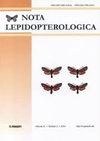Mitochondrial DNA-based phylogeography of the large ringlet Erebia euryale (Esper, 1805) suggests recurrent Alpine-Carpathian disjunctions during Pleistocene (Nymphalidae, Satyrinae)
IF 0.7
4区 农林科学
Q4 ENTOMOLOGY
引用次数: 0
Abstract
. Most species of the butterfly genus Erebia are high altitude specialists, in which territorial fragmentation is associated with distinct genetic patterns. This is also true for the large ringlet, Erebia euryale (Esper, 1805), a species widespread across European mountain systems. Previous molecular studies revealed four lineages: two in the Alps, coinciding with the ssp. adyte and isarica, one in the Pyrenees and Cantabria (ssp. pyraenaeicola), and one in the Carpathians and the Balkans (ssp. syrmia). Two morphological subspecies inhabiting delimited ranges in the southern Alps (ssp. pseudoadyte and kunzi) were not included in these studies. To further our understanding of the relationships between populations, both the Alpine and the extra Alpine ones, we sequenced 1,496 bp of the COI gene in 16 Alpine and Jurassian populations and analysed them in combination with published Pyrenean and Carpathian sequences. The resulting haplotype network shows five lineages, congruent with the morphologic delineation of subspecies. Based on the current distribution ranges and genetic affinities, we reconstructed a pre-Würm phylogeographic scenario. This suggests an initial split resulting in an Alpine and a Carpathian clade, probably of Carpathian origin. Within the Alps, three subspecies subsequently differentiated, probably during several glacial cycles, generating ssp. adyte, pseudoadyte and kunzi. In parallel, the Carpathian clade underwent a second Alpine–Carpathian disjunction and differentiated into ssp. euryale and syrmia in the Carpathians, and ssp. ocellaris and isarica in the eastern Alps, revealing a heterogeneous origin of the E. euryale subspecies across the Alps. The Pyrenean and Jurassian populations are a relatively young divergence in the western part of the species’ range.Mitochondrial基于dna的大环虫Erebia euryale (Esper, 1805)的系统地理学表明更新世期间阿尔卑斯山-喀尔巴阡山脉的分离(蛱蝶科,蛱蝶科)
。蝶属的大多数物种都是高海拔的专家,其领土的分裂与独特的遗传模式有关。这种情况也适用于大的小环鹬,eerebia euryale (Esper, 1805),一种广泛分布于欧洲山地系统的物种。先前的分子研究揭示了四个谱系:两个在阿尔卑斯山,与ssp一致。adyte和isarica,一个在比利牛斯山和坎塔布里亚。pyraenaeicola),喀尔巴阡山脉和巴尔干半岛(ssp.。syrmia)。两个形态亚种居住在南阿尔卑斯山的划定范围内。Pseudoadyte和kunzi)未包括在这些研究中。为了进一步了解阿尔卑斯和非阿尔卑斯人群之间的关系,我们对16个阿尔卑斯和侏罗纪人群的COI基因进行了1496 bp的测序,并与已发表的比利牛斯和喀尔巴阡人群的基因序列进行了分析。由此得到的单倍型网络显示了五个谱系,与亚种的形态描述一致。基于目前的分布范围和遗传亲缘关系,我们重建了一个wrm前的系统地理情景。这表明最初的分裂导致了阿尔卑斯和喀尔巴阡的分支,可能起源于喀尔巴阡。在阿尔卑斯山脉内,三个亚种随后可能在几个冰期循环中分化,产生了ssp。Adyte, pseudoadyte和kunzi。与此同时,喀尔巴阡分支经历了第二次阿尔卑斯-喀尔巴阡分离,并分化为ssp。喀尔巴阡山脉的芡实和叙尔米亚,以及ssp。在阿尔卑斯山脉东部发现了眼孢菌和伊萨里菌,揭示了横跨阿尔卑斯山脉的欧孢菌亚种的异质起源。比利牛斯和侏罗纪的种群在物种范围的西部是一个相对年轻的分化。
本文章由计算机程序翻译,如有差异,请以英文原文为准。
求助全文
约1分钟内获得全文
求助全文
来源期刊

Nota Lepidopterologica
Agricultural and Biological Sciences-Insect Science
CiteScore
1.70
自引率
14.30%
发文量
20
审稿时长
14 weeks
期刊介绍:
Nota Lepidopterologica is the scientific, peer-reviewed journal of the Societas Europaea Lepidopterologica (SEL). It publishes original contributions to the study of mainly but not exclusively Palaearctic Lepidoptera, especially on taxonomy, morphology/anatomy, phylogenetics, biogeography, ecology, behaviour, and conservation, but also on any other aspects of lepidopterology.
All articles are published in English, with the possibility of having the summary written in other languages. All submitted manuscripts are subject to peer-review by the leading specialists for the respective topic. The journal is published in open access high-resolution PDF, semantically enriched HTML and machine-readable XML versions.
All papers can be freely copied, downloaded, printed and distributed at no charge. Authors and readers are thus encouraged to post the pdf files of published papers on homepages or elsewhere to expedite distribution. Publication is free for the SEL members and there is no charge for color.
 求助内容:
求助内容: 应助结果提醒方式:
应助结果提醒方式:


